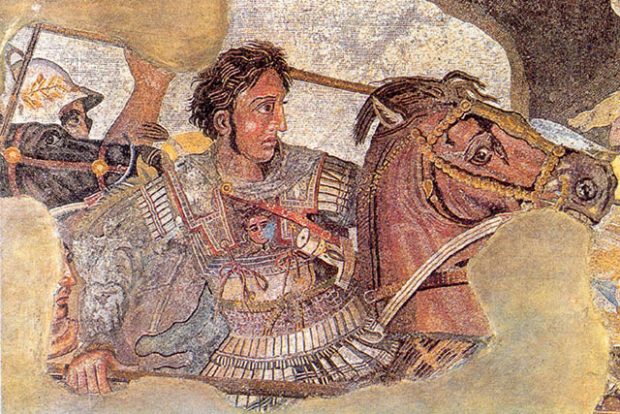Cognitive-Enhancing Drugs
Neuropsychologist Barbara Sahakian on episodic memory, the symptoms of schizophrenia, and the drugs used in Al...
Today, if someone is interested in finding out about the natural world, about scientific subjects, there are lots of different ways to access information and different theories – go can go on the Internet, of course, turn on the television, look at a magazine, read a textbook. In antiquity as well there were lots of different forms of communication about the ancient world. In fact, when we look at the ancient texts that survive in Greek and Latin about the natural world, we might be surprised at their richness and variety of the sorts of texts that were there. For example, poetry in antiquity was a very powerful mode of communicating about the natural world. Some of the most important and popular texts that survive from antiquity about the natural world were actually poems. When I talk about popularity in the case, for instance, of Aratus’s poem ‘On Astronomical Phenomena’, we know that he wrote it in ancient Greek and it was translated in antiquity into Latin many times by different translators. We also know that some of those Latin translators updated his poem with new astronomical information. One of the things that is very interesting about Aratus’s poem is that the astronomical information that he includes and reports in his poem is actually based on an earlier prose work by someone called Eudoxus. Eudoxus’s prose work no longer survives, but Aratus’s poem does.
Of course, not all ancient works about nature and mathematics were written in the form of poetry, but it might be surprising to know that some very interesting and challenging poems were about mathematical problems. So, for example, there is the very famous problem that’s called ‘the cattle problem’ and it’s attributed to the mathematician Archimedes. It’s also interesting because it was addressed to another ancient figure, a scholar known as Eratosthenes, who was the librarian at Alexandria. Eratosthenes was known in antiquity for his range of interests: he wrote for, instance, on Homer’s poems and he was also interested in various mathematical topics. We know from the beginning of ‘The Cattle Problem’ that Archimedes has addressed this to Eratosthenes – one can understand that this would have been sent in a letter to him and that it would have been sent across the sea from Syracuse to Alexandria. We have a number of letters that survive from antiquity – another important form of communication – we have a number of letters that survive, that were apparently transmitted and sent between different mathematicians in antiquity or people who were very interested in mathematics. People would be sending each other problems – in some cases solved, in other cases not. Letters were also used by other people who were interested in the natural world and mathematics in antiquity. I’ve already mentioned Epicurus, some of whose ideas were transmitted by Lucretius. Three of Epicurus’ letters survive – they were collected by a much later author Diogenes Laertius, and he includes these letters in his biography of Epicurus. In one of the letters that survive, Epicurus explains that he has written it so that his followers would have a very easy form to resort to when they wish to consult a text on his ideas without having to read a long account of his ideas. It’s a sort of aide memoir – something just to refresh the memory about his important ideas.
There are many other sorts of types of texts that survive from antiquity about mathematical topics and scientific topics. One, for instance, is the biography that I’ve already mentioned. It’s not entirely clear whether or not it was an entirely separate genre in antiquity, but there were many different accounts of lives that were written about ancient philosophers and mathematicians. We have, for example, several accounts of the life of Pythagoras that survive. One we find in Diogenes Laertius, another survives in a later author called Porphyry and in his student Iamblichus. It is very interesting, because when we look at these accounts of Pythagoras’ life, we see that in the account by Iamblichus he shares some characteristics with Jesus. So, for instance, both are sons of God and both are the progeny of a virgin. And we can immediately see that there are certain parallels between the Iamblichus’s life of Pythagoras and the Christian gospels. And when we consider the time in which this was written we can perhaps imagine that Iamblichus may have been giving us his account of Pythagoras as a very important intellectual and religious figure who may actually have been somewhat in competition in certain circles for followers in that historical period. We know, even from looking at the writings of later authors, for instance, of Galileo and Kepler – they have communicated with each other by letter and they said that they were brothers in Pythagorianism. We see again the importance of letters being a form of communication, but also biography as conveying very important ideas about who these people were and how they figure in the culture of their period.

We have various accounts from different ancient authors that tell us how people they knew dealt with specialists who were promulgating different technical ideas. We have Eratosthenes, the playwright making fun of people talking about clouds in his play ‘The Clouds’. We have a much later author Plutarch in his dialogue ‘On the Face on the Moon’ giving us a very detailed account of a group of men who are conversing together, going for a walk, talking about the nature of the moon, what is the ‘face’ on it and how do we know about it. They ask questions about how we gain knowledge about the moon and about distant objects. So we get some sense that people, in general, those, who were presumed to be educated, those going to the theater, who attend different performances of various text being read out – that these were the sorts of things that people thought about. In fact, in Plutarch’s dialogue that I just mentioned, the narrator says: “This is a question – what is a face on the moon? This is a question that is on everyone’s lips”. This gives us the impression that these are the sorts of questions that people in antiquity would have wondered about, just as many people do today.
In addition to the written text we also have some evidence from the archaeological remains and some artworks that show us an indication of how the natural world was depicted, for instance, in art. We also have some idea of some scientific instruments. For example, Aristotle talks about the wind being portrayed on different vases and when we look as some Greek vases we can see that certain Gods are represented as winds. There are also some stone inscriptions that survive, that also would have served as instruments. I’m thinking in particular of the inscriptions that we call ‘Parapegmata’ – they are stone inscriptions that have holes drilled in them, that are a form of calendar that correlate astronomical phenomena with weather events: there were holes in the stone in which you would have placed and moved a wooden peg to count out different days. Several fragments of this survive and are on display in a museum in Berlin. We also have many sundials that survive from antiquity, some of which were probably purely decorative and would not have been inscribed accurately and would serve as garden ornament, for instance, for a villa in Pompeii; but some were very sophisticated and would have been used as a form of calendar as well as being used to tell what time of day it was.
One of the challenges and frustrations in terms of studying ancient texts about the natural world is that in some cases what we have is only fragmentary. So, for instance, Plutarch’s dialogue ‘On the Face on the Moon’ is missing the beginning part and we don’t know what the beginning said. I’ve mentioned already the fragments of the Presocratics – it would be wonderful to have those complete texts. In some cases – and I think here of Aristotle – what we have seems to have been not his original words in some cases, and so the texts seem to be a little bit garbled and hard to understand and we might wish to have a better, more direct version of it. So I think that that is one of the challenges and most hopes that we have in terms of studying ancient science – hope springs eternal – are that we might get a better version or find a fragment. And of course this happens from time to time and it is very exciting when they do.

Neuropsychologist Barbara Sahakian on episodic memory, the symptoms of schizophrenia, and the drugs used in Al...

Behavioral geneticist Robert Plomin on the prediction of GCSE results, reading disability, and the heritabilit...

Philosopher and neuroethics expert Thomas Metzinger on the limitations of consciousness in natural and artific...